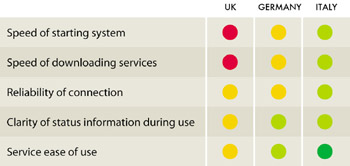Distinguishable Services and Critical Mass
|
|
In the field trials the overall rating of the quality of mobile service provisioning was positive for most end users in all countries. The highest quality ratings were given to such quality dimensions as reliability of connection, clarity of status information during use, and ease of use of the services. Most users found the services and equipment to be easy to use and attractive, and to furnish sufficient navigation methods. The end users appreciated in particular automatic reestablishment of connection, HTML page transfer, SMS services, and clearness and richness of information. Their criticisms concerned the slowness of loading the program and the need for more compact equipment. Expectations for mobile multimedia technologies seemed to be independent of country.
Expectations for service content, however, depended more on local culture and on the way the trial services were implemented in different countries. Three key criteria for successful service content provisioning were isolated:
-
Time-saving capability
-
Distinguishable from existing media channels
-
Presenting the user with a critical mass of service options
The mobile user, a business user at least, experiences the service as beneficial if it is possible to save time with it. Entertainment services, on the other hand, are beneficial if they help the user spend time during idle periods. Service airtime and subscription expenses aside, busy users will regard their efforts to install and maintain the service software, and to download content from it, as additional costs of use. Any possible time savings the service yields may be negated if maintaining the systems starts to take too long.
Among the services tested, city information, traffic information, and short message notification of traffic conditions were regarded as very attractive. Traffic information offered data that was not otherwise accessible. Weather and news services, on the other hand, were not considered attractive. Services in which subjects exhibited less interest were not sufficiently distinguishable from existing media channels, namely, TV, newspapers, and wired Internet services. Competition between information channels gives the end user several choices besides the mobile Internet.
Consistent with those findings, location-based services have added value with which to attract users in comparison with the general-purpose Internet services. In Italy, where the Milan traffic service was offered, users saw services as more mobile-oriented whereas in Germany and the United Kingdom only general travel information was provided (see comparison in Figure 10.7). Thus, overall satisfaction in Italy measured higher on all scales. Traffic service is also an example of a time-saving service.

Figure 10.7: The ratings of services in different countries reflect the differences in service implementation. Overall rating on developed mobile services in Italy was clearly more positive than that of a selection of public services provided in the United Kingdom.
To sum up, mobile access cannot in itself be assumed to be a remarkable benefit for every category of services. The benefits were perceived only when content was specially tailored to fulfill needs in mobile usage situations.
Another finding with respect to the acceptability of mobile multimedia services is that it seems to hinge on the availability of a sufficient number of advanced mobile services. The availability of new technical solutions is not sufficient to attract consumers unless there is enough drive on the service provisioning side as well. Once providers exceed critical mass in the variety of services offered, the users are able to find the ones that match with their personal preferences, needs, and expectations. They begin to be willing to access mobile services repeatedly, which leads to behavioral learning and to the adoption of those services. Of course, a personalized service portfolio is possible only if the selection is big enough and the user has the freedom to choose. Note that this means that a single user is not supposed to continuously consume a large number of different services; range is necessary for offering the appropriate selection.
|
|
EAN: 2147483647
Pages: 142